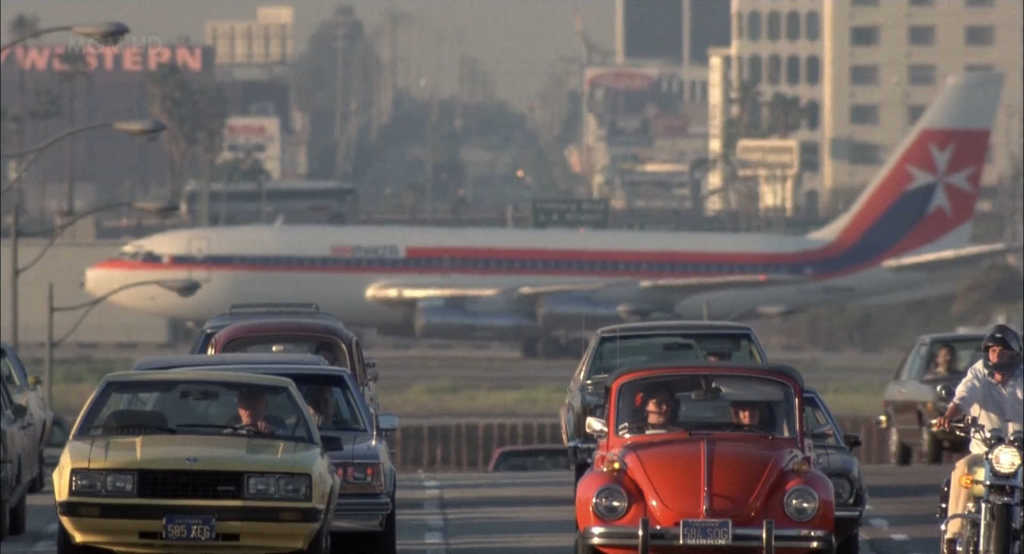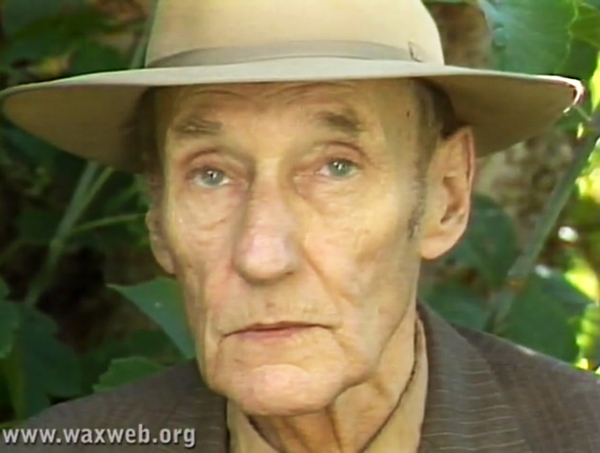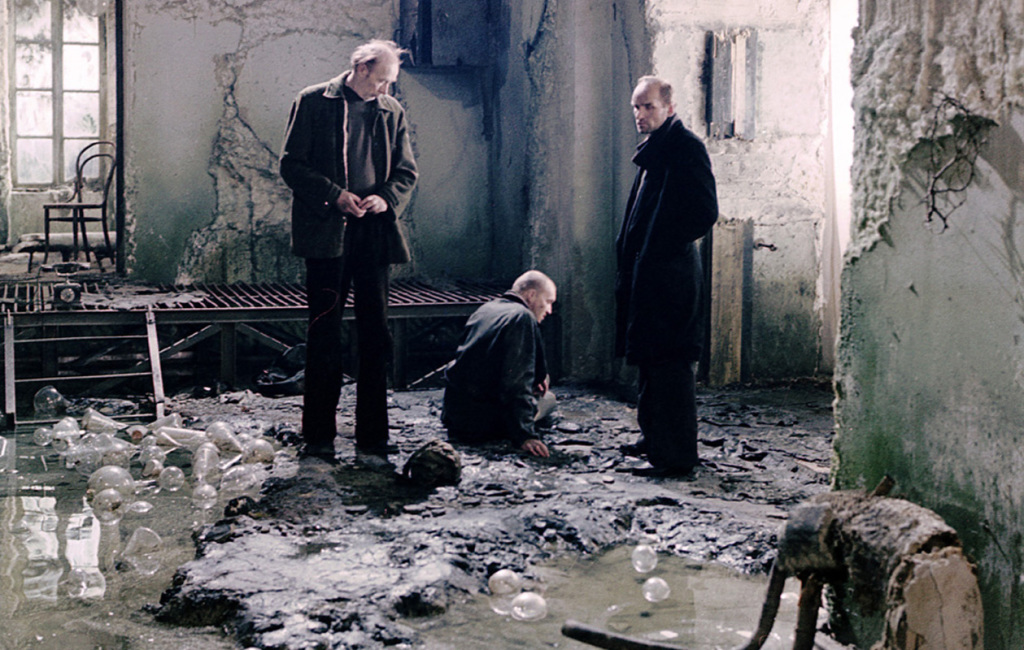by David Cox
David Cox appears at Other Cinema’s 3/26 show, Psychogeography 1.
The Holocene is over and the Anthropocene defines our epoch. Humankind’s irreparable and irreversible influence on the face of the planet will totally define its fate from now on. I’ll discuss several feature films that have as their central idea and theme human impact on the planet
Koyaanisquatsi, “Life out of Balance”, the epic 1982 documentary by Godfrey Reggio with music composed by Philip Glass and cinematography by Ron Fricke shows the human impact on the environment and culture through a cornucopia of time-lapse, slow motion and panoramic vistas of spectacular yet fragile landscapes. I first saw this work of art on film at the Valhalla Cinema, a repertory theater in Richmond, Melbourne whose audience was mainly students and switched on counter-culture types. I remember the kaleidoscopic cascade-like film playing to row after row of amazed Melbournites.
Among those who saw it (if Underground: The Julian Assange Story, a made for Australian television audience biography from 2012 is to be believed) was a very young Julian Assange. In the film production of his life, he is shown with his girlfriend in the audience, presumably at the Valhalla, amazed by the film and viewing within it a kind of call to action.
The semi ad-hoc nature of the way Koyaanisquatsi has been made complements the wild theme-based structure. It is a symphony of shots that leave you with the sense that the world is mad with development and that our impact as a species on the planet is without limit or direction. The film was made in a piecemeal way from a collection of time-lapse shots, archival material as well aerial footage. The film is planetary in scale. The Grand Canyon, Cityscapes at night, Los Angeles Airport, Factories, People in Motion through Times Square, Portraits of New Yorkers along with close ups of such banal things as hot dog manufacture, when played as part of the relentless repetitive soundtrack of Philip Glass’ postmodern score create a wildly frenetic yet at time picturesque and timeless record of the planet.
Made at a time when Chaos theory was starting to emerge as a set of ideas in which computers made formerly hidden orderly patterns visible in the details of coastlines, and branches, leaves and the way rivers are formed when seen from high altitude, Koyaanisquatsi was its own world manifesto – an Anthropocene movie for the 1980s at a time when the Western economies were only just beginning to realize the scale of their effect on the global ecology and what we might call the ‘global sensibility’.
Three Hopi prophecies sung by a choral ensemble during the latter part of the “Prophecies” movement are translated just prior to the end credits:
- “If we dig precious things from the land, we will invite disaster.”
- “Near the day of Purification, there will be cobwebs spun back and forth in the sky.”
- “A container of ashes might one day be thrown from the sky, which could burn the land and boil the oceans.”
Wax: Or the Discovery of Television by the Bees an experimental science fiction film by David Blair (1991) was prescient in fusing a vision of a world in which a Middle-Eastern war, photography, mathematics, and geometry had resulted from fusion of communication between bees and humans.
A synopsis by Anthony Reed sums up the film nicely:
Director Blair pieced Wax together over a period of six years, writing the film as he edited it, letting creative accidents and “directed random readings at the public library” (as Blair puts it) guide its creation. The result is a work much like the early structuralist films of British director Peter Greenaway, an obsessive, artificial history which has been fastidiously detailed with fragments of real and imagined facts. The film is set at a flight simulation factory in Alamagordo, New Mexico, where Jacob Maker (Wax’s narrator, played by Blair) is a computer programmer. Jacob designs gun sight displays and lives with his wife Melissa near the weapons testing range. He is also a beekeeper, whose “Mesopotamian” bees have been handed down to him from his grandfather, Zoltan. These bees are not ordinary bees; they have the power to put thoughts and images into Jacob’s mind, and Jacob soon realizes that he is able to personally identify with the weapons he is helping to create. One day the bees put a special “television” in Jacob’s mind. Through the bee television Jacob is subject to a bizarre series of fictions and hallucinations, and is finally lead by the bees to their subterranean home: an enormous cave below the Alamagordo desert. In the cave it is revealed to him that he must actually become a weapon and destroy his “target” in Iraq, before rebirth in a new body. Wax wears its low-budget origin on its sleeve (it was shot on video) but has enjoyed an art-house reputation due to its wild imagination, its hybrid media existence as part-film-part-Internet-site, and its similarity to works of postmodern literature. Enthusiasts of Greenaway’s early films, and readers of Jorges Louis Borges, Italo Calvino, and Thomas Pynchon, should look this one up.
Wax arrived at a time when both its means of production and the themes it was addressing converged elegantly via the then brand new dimension of the Internet. I was able to count on one hand the number of people I could email when the film was released, and the terror and possibilities of new modes of communication we all felt in these early days are beautifully embodied in the film. William Burroughs himself wanders through the film, ambassador of all that is juxtaposed and otherworldly, and it is fitting that he should preside in this world, which seems to speak to our neo-liberal wasteland today, devoid as it is rapidly becoming, of its UBER influence over Alles.
The war in the Gulf, the rise of war technologies, mapping systems, the fact that the Bush administration was descending upon the region formerly known as Mesopotamia, cradle of civilization, origin point of symbolic language, birthplace of mathematics, and more than one bloodbath in the name of religion and natural resources made the timing of Wax all the more prescient. Through the device of a special camera that could contact the dead, as well as a trans-species communication with bees, the central character (shown to be William Burroughs himself) must decipher the riddles of the landscape.
Wax cascades the viewer with scene after scene equating weapons and targeting technology with religion, abuse of the landscape, the need to appreciate history, understand how time and distance operate. The beekeeper’s suit and the spacesuit are virtually interchangeable in a landscape where planes destroy desert targets and where bees form vast pyramids out of computer generated symbols that point to the nature of origin of the universe.
Powers of Ten by Eames Studio took the time to show the relationship of Earth to its planetary neighbors, and at the same time revealing the makeup of human matter at the atomic scale. This mind-boggling animated journey into scalar depiction and scientific humanist relativism became the mainstay for many a high school and college study session. It ponders the big questions about our place in the universe and the universe in us. It was not the first film to examine the universe from the point of view of relative exponential scale (Cosmic Zoom predated it by several years) but it was certainly the first to do so in a way that precisely understood the relationship between all this cosmic measurement and the role of companies like IBM who distributed the film, and the way that such corporate sponsorship of the eternal would come to define the world in which we live today. The Anthropocene is nothing if not brought to you by the Biggest of the Big Players, then as now.
Relativism as ideology is laid bare here – “everything needs to be thought of in relation to its grander and tinier neighbor”. The universe is one big telescopic tunnel of one set of objects in relation to another. Like its art world sister film by Michael Snow Wavelength, Powers of Ten invites the viewer to ponder what it is to consider a zoom shot as an event in and of itself, a moment of time and space compressed, contained, cordoned off for analysis or rumination. Like the quasi mystical experiences many astronauts describe on return to earth, the process of pondering our place in the universe when faced with the unimaginable in terms of the fragility and relative insignificance of earth is food for thought indeed.
The Stalker (1979) by Andrei Tarkovsky is noted for its stark use of gritty, earthy close ups of mud, swamps, and the very material makeup of the planet itself. It shows a journey led by the ‘Stalker’ (Aleksandr Kaidanovsky) to take his two clients, a melancholic writer (Anatoli Solonitsyn) seeking inspiration and a professor (Nikolai Grinko) who seeks scientific discovery, to a place known as the ‘Zone’, which has a place within it with the supposed ability to fulfill a person’s innermost desires.
The three travel through unnerving areas filled with the cast-off material of modern society. They yell at each other, and on confronting the ‘Zone’ it would appear that it is in fact alive. Traversing “The Zone” can be felt but not really seen. The Cacophany Society’s Carrie Galbraith has said that the original “Burning Man” event was in fact one of several “Zone Trips” that were inspired by “The Stalker”, number 4 in fact, and the idea that a sentient earth receptive to the thoughts of those that engage with it is entirely consistent with the ideas of utopian groups who offer alternative uses for Federal desert land such as the Center for Land Use Interpretation. The contemporary Burning Man is a far cry from the ad hoc aims of those who interpreted the same site for “Zone Trip Number Four”, and the world is worse for it.
Slavoj Zizek has noted that in classical Marxist materialist logic, in lieu of religion is made manifest in “The Stalker” to be an obsession with the very ‘stuff’ that makes up that beneath our feet. Don’t look up to heaven for transcendence, look down; at the shit, the mud, the earth, the swamp and all the fine grained individual particles of dirt and muck that make up our lives on this most finite of planets. For the effect-of-man-on-the-earth should be measured thus, the better to take account of all that has been moved out of place in the name of modernity, and all that has unfolded since.
The documentary Manufactured Landscapes, directed by Jennifer Baichwal is about the work of photographer Edward Burtynsky whose work concerns itself with the impact of massive manufacturing plants on the earth’s environment. Enormous factories, large scale infrastructure programs, many of which are in mainland China form the basis of this extraordinary film about the bigger picture of global trade and its scarring effect on surface of the earth, and demands it makes on those caught in its seemingly unstoppable flows.
The film is not intended, one suspects as any kind of direct polemic on globalization and its devastating environmental impact, rather a kind of filmic extension of the photographic project of Burtynsky himself. He remains in my opinion rather diplomatic when describing his position in relation to China in terms of environmental impact of manufacturing in the film. Were Manufactured Landscapes more of a polemic and less of a record of an artist it might pull fewer punches in terms of taking a stand about the impact of all those factories belching so much smoke into the atmosphere, or all that toxic waste polluting so much water in the e-waste trash piles of rural China. As with Koyaanisquatsi we are left to ‘make up our own mind’ rather than have a view framed for us, but sometimes an ideological framework is just what is needed.
Together combined, the above films make for an elegant mini film festival on the Anthropocene – call it Anthropocinema. Thankfully, most are online for free. Stage your Anthropocinema festival from your laptop tonight!
Clips and trailers:
Koyaanisquatsi on Vimeo:
Wax: Or the Discovery of Television by the Bees
https://www.youtube.com/watch?v=aDzl6SBCX0c
Powers of Ten – Eames Studio (1977)
https://www.youtube.com/watch?v=0fKBhvDjuy0
The Stalker (1979) by Andrie Tarkovsky
Part 1
https://www.youtube.com/watch?v=JYEfJhkPK7o
Part 2
https://www.youtube.com/watch?v=hUHBgqx8YP8




